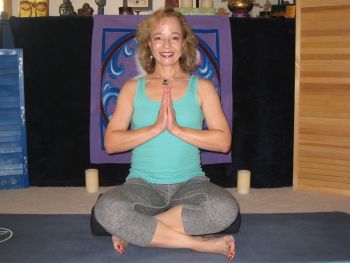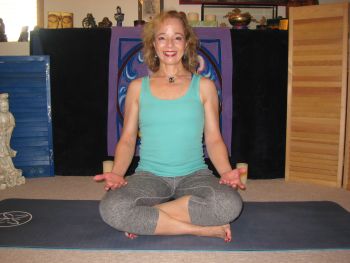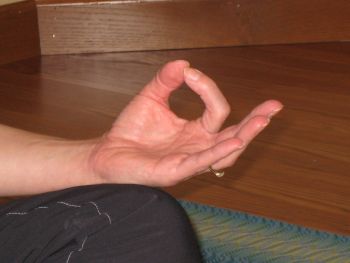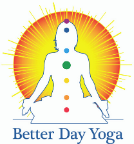
Easy Seated Pose (Sanskrit term: Sukhasana)
This newsletter is about not only connecting to the energy of your ancestors, which lies in your DNA, but healing their unresolved conflicts, emotional wounds, damaging judgments, and other limitations that continue to influence generations to follow. This pose connects you to your root chakra as well as your crown chakra when used as a meditative pose. It connects you to your roots—your tribe—and to the energy funneled from the heavens.
Benefits:
- Calms the brain
- Creates inner harmony
- Raises awareness
- Rejuvenates tired legs and back
- Strengthens the back
- Stretches the knees and ankles
Alignment Cues:
Sit on a bolster, meditation cushion, or a couple of blankets to elevate the pelvis and release your hips. Cross the legs at the shins and align the feet under the opposite shin bones. Distribute your weight evenly over the sitting bones, balancing your shoulders directly over the hips with head on top of your spine. Sit up tall, elongate the spine, lifting out of the abdomen while opening the chest, collarbones wide. Keep the abdomen strong. Lengthen the neck, reaching your crown toward the sky as you soften your throat. The challenge is to not sink back into your hips and low back or tip too far forward in the pelvis. Balancing on the center of the pelvis enables your sacrum (the upside-down triangle at the end of your spine) to move in maintaining your natural low back curve. Leave a “comfortable gap” between the feet and the pelvis.
Bringing the hands to prayer/Namasté position at the center of your chest will help you to expand your chest, bring your shoulder blades back and down, and firm your upper back muscles.

Once you’ve established that expansion, shoulder blade position, and upper back muscles are held firm, you have the option to keep those qualities and rest your hands on your knees.
I often invite my students to “play” with energy here. Palms down on the knees feels more grounded, centered within and focused:

Palms up on the knees feels more open, energetic and ready to receive.

You get to decide on any given day just what energy you are looking for, and then I add that it’s okay to have one hand palm up and one hand palm down if you aren’t sure, or want both. Drilling down to the subtle effects of hand placement introduces even the most conservative folk to experience energy.
You can also add a hand mudra here. Perhaps add the “Chin Mudra”. Connect index and thumb and extend the last three fingers of your hand with palms facing up. (If you have one palm down, you can still do this same mudra, it would change names to Jnana Mudra.)

Keep the head centered between the shoulders. Again it’s a balance of expanding but not so much that you overarch your low back and move your lower ribs forward. It’s always a good idea to alternate the cross of the legs if you sit in this pose regularly. Our patterns create imbalances and our yoga practice is a great place to remind ourselves to balance the body.
Beginners:
Loosen the cross of your legs so the arches of your feet rest closer toward the opposite ankles. I even have one student who chooses to sit in butterfly pose instead of easy-seated pose as this is more comfortable for her. “Customize” the pose to fit your body.
“Sit with your back to a wall, slightly closer than the length of a yoga block, and wedge the ends of the block between the wall and your lower shoulder blades.” (Not shown) http://www.yogajournal.com/poses/2481
Advanced Option:
While an “advanced” version of easy seated pose could be lotus pose, I don’t promote lotus pose since:
1) I personally can’t do it and
2) At least one expert in the area doesn’t promote it due to possible injuries attained from practicing lotus pose:
http://yogaanatomy.net/lotus/ (The lotus dilemma. As this well-known expert says—the benefits aren’t necessarily always worth the risk.)
Contraindications and cautions:
- Knee injury
- http://yogaanatomy.net/lotus/
Spiritual aspects of Easy Seated Pose:
Easy seated pose is often used for meditation. Your Hatha yoga practice was originally intended to enable the body to be still in a meditative pose for long periods. Once you start your meditation practice, coming to easy seated pose is like “Pavlov’s Dog” for your body. Your body knows it’s time to connect within. There’s nothing more spiritual than that connection.
In easy seated pose, you look down and see a triangle—three sides formed by the two thighs and the crossed shins. Trinities appear in many of the world’s religions and cultures—Father, Son, and Holy Spirit; Brahma, Vishnu, and Shiva; Mother, Maiden, Crone; Mind, Body, Soul.
The lucky “cat with nine lives” derives from the auspiciousness of three. Nine is composed of three trinities (9 = 3 x 3); and is considered to be “sacred three times”—the highest expression of sacred.
In the light of sacred geometry, simply finding easy seated pose in your yoga practice becomes the highest expression of sacred—the blending of mind, body, and soul.
Sources:
- http://www.yogajournal.com/basics/1299 and http://www.yogajournal.com/poses/2481
- Yoga to the rescue remedies for real girls cards by Amy Luwis.

